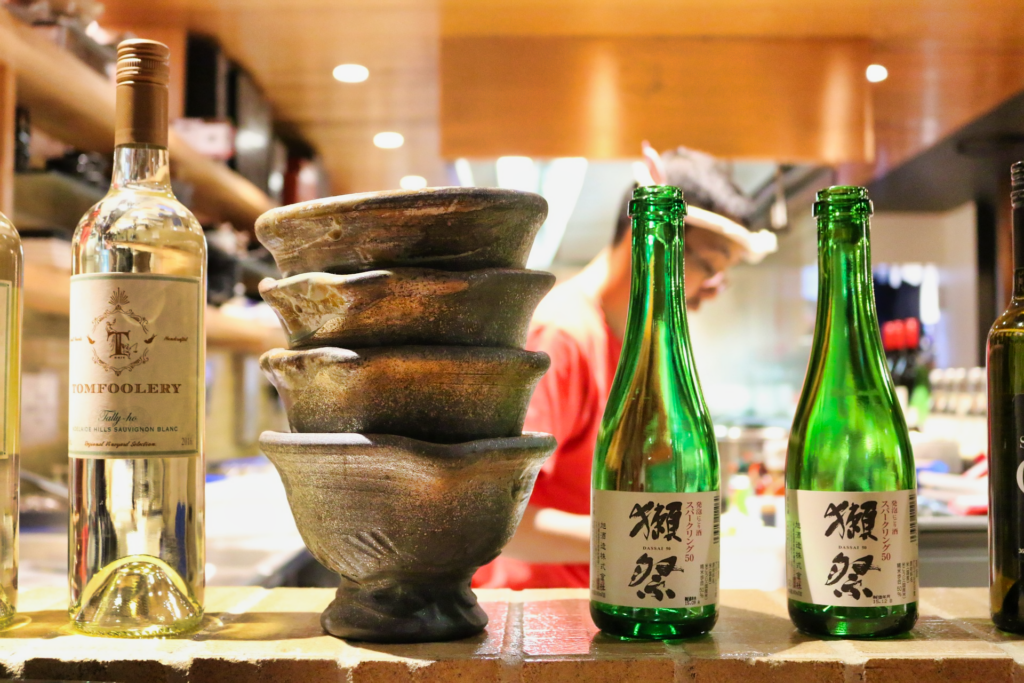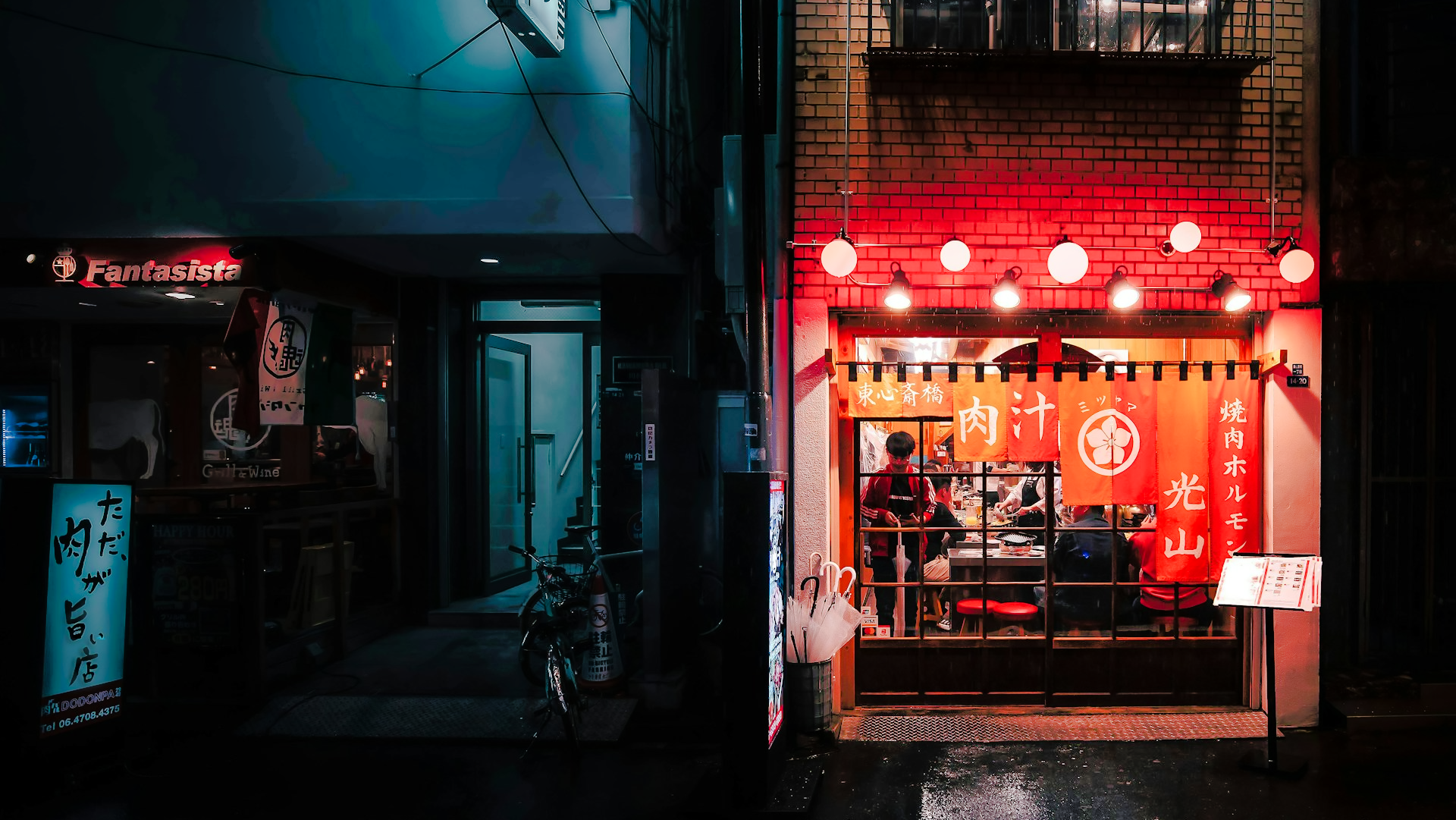Have you ever heard of an izakaya before? If not, you’re about to find your new favorite hangout spot in Japan. Although Japan is an introvert’s heaven, there are places for people to hang out and socialize. I mean there have to be, right?
So imagine a cozy place where you can kick back after work, enjoy an endless array of tasty dishes, and wash it down with some good drinks while catching up with friends or making friends with strangers. Sounds like an ordinary pub, right? Well, that’s precisely what an izakaya offers!
What Exactly Is an Izakaya?
An izakaya is best explained as a Japanese pub but that doesn’t tell you much does it? Think of it as a hybrid between a bar and a casual restaurant, with every aspect focused to help you socialize with strangers over food and drinks.
The word ‘izakaya’ comes from “i” (to stay or be in a place) and “saka-ya” (sake shop or house). Traditionally, they were places where people would buy sake (nihonshu) by the carafe (tokkuri) and stick around to enjoy their drink with some snacks.
Izakayas today offer more than just sake; you’re in for cocktails like highballs and umeshu (plum wine), draft beers by the glass, shochu glasses, soft drinks and of course the food.
The vibe: cozy & casual

Step into any izakaya whether it’s hidden away in a sketchy narrow alleyway or visible while walking along busy city streets and you’ll find yourself in a warm and cozy place where friends are but a few glass clinks away. Many feature counter seating facing open kitchens where chefs craft your orders while chatting with customers from across the bar counter.
You’ll also find small tables to the sides buzzing with groups engrossed in conversation over clinking glasses and sometimes larger tatami rooms traditional style in the back if it’s a larger establishment.
What makes these spots special is how welcoming they are. A staff member (or all all the staff) will holler “Irasshaimase!” (Welcome!) with a smile before you’ve pushed past that noren curtain at the entrance. You either pick a seat near the counter if you’re alone and want to make friends or take a seat at one of the side tables to have semi-private conversations.
Menu selections galore

It’s not possible to enjoy an izakaya without ordering a few samplings of food to go with your drinks. I mean, it’s not as enjoyable to sit there and drink like a solemn salaryman.
So what’s available? It depends on your local izakaya but here’s a few options that you can commonly expect and should try out if you get the chance.
- Karaage – Japan’s version of crispy chicken nuggets is mandatory if you’re gonna enjoy your beer.
- Edamame – Boiled and salted soybeans, usually served complimentary as an appetizer with the beer (don’t eat the shell).
- Tempura – Lightly battered fish, shrimp & veggies fried to a crispy golden brown.
- Yakitori – Tender, bite-sized skewered chicken charcoal grilled.
- Yakiniku – Charcoal grilled beef or pork usually served with dipping sauces.
- Sashimi – Nothing goes better with sake than freshly sliced raw fish (usually at more upscale izakayas)
There’s of course a hundred other dishes you can order and every establishment has their own specialties. But knowing these 6 is enough to get you started. Speaking of getting started, what drinks will you order?
From mundane drinks to unique cocktails
Izakaya food is great, but it exists to pair with the drinks you’re about to have. So what can you order? And perhaps more importantly, what should you order?
Sake & shochu: The classics
First up, there’s sake (locally known as nihonshu). This staple can be enjoyed warm (atsukan) or cold (reishu) and ranges from sweet to dry varieties. You might get it served in small ceramic cups called ochoko, often poured from a tokkuri (a ceramic sake carafe). These pair great with many of the sashimi or fish innard dishes. Be sure to ask for recommendations on which temperature pairs best with your dishes.
Shochu is another traditional choice. Distilled rather than brewed like sake, shochu tends to boast a higher alcohol content and comes in flavors derived from ingredients like barley, sweet potatoes, or even chestnuts. It’s typically served neat, on the rocks, or mixed with hot water. Perfect for sipping leisurely as you munch away.
Highballs & cocktails
If you don’t have the stomach for drinking liquor neat, no worries. Japanese highballs are incredibly popular at izakayas. These refreshing cocktails mix whiskey with soda water (often coupled with a splash of lemon), creating an easy-to-drink delight that’s both light and fizzy.
Want something fruitier? Opt for a chuhai which is generally shochu mixed with fruit juices and shochu. It’s a nice drink without the bite of neat alcohol.
You’ll also come across umeshu (plum wine) which is Japanese plums fermented in shochu and sugar or honey. It’s delectably sweet but potent enough to make you regret not pacing yourself.
Beer
Let’s not forget the fact that a pub isn’t complete without copious amounts of beer served. You’ll usually find Kirin or Asahi on tap at these locations, sometimes Sapporo. They’re all good in their own way but Japanese beers lean on the lighter side.
That means they’re great with food but won’t stimulate your craft beer love the way many darker ales would. Though you can find neat bottles being served here and there, these pubs are usually not the place for that.
Other drinks
Most pubs will also serve drinks like vodka, whiskey, rum and gin which you can order to your heart’s desire but where’s the fun in that? You’ve already gone out of your comfort zone and gone into an Izakaya, might as well be fully adventurous right?
That said, if you’re unable to drink at all, most izakayas serve non-alcoholic options usually in the form of cold teas.
Tips when visiting an izakaya

Sounds good and all but it’s a bit intimidating to just hop into a pub in a foreign country and make friends when you don’t even know the language isn’t it?
Don’t worry, the atmosphere might be overwhelming but the people are at their most welcoming in these establishments. If you’re willing to make an effort to communicate, they’ll do so in return. That being said, here’s a few things to keep in mind on your first visit:
- Reservations – For larger groups, it’s better to call ahead of time and avoid standing line during peak times, especially weekends.
- Ordering System – For ordering, you just casually call out or raise your hand to the staff and ask for food. Nothing complicated right? Generally, there will be menu items written on the walls and physical ones at your disposal. There won’t always be English menus but most places have pictures on their menus and you can use your Google Translate app’s camera feature to help you make a choice.
- Shared Platters – Be aware that most dishes served are small portions like tapas. This allows you to try a lot of things without bursting your stomach and helps cleanse your palate from flavor fatigue. This also means you can try quite a few dishes if you bring a friend or two to share.
- Kanpai! – Part of the fun of an izakaya is that you can bond with any stranger by raising your glass and saying kanpai (cheers) knowing you’ll get a smile and a positive response regardless of the language barrier.
Experience and enjoy!
Don’t be antisocial and eat convenience store foods for your entire Japan trip. Whether you’re traveling Japan alone or with friends, it’s worth stopping by these shops and having a chat with the locals even with the language barrier. Who knows? You might just make lifelong friends.
If not, you’ve at least had a good time, some good drinks and had some incredible food for cheap.
By the way if you ever find yourself in Tokyo and in the mood to try some izakayas off the beaten path, check out Okawari’s tours. He and his team are friends of Fuji Daily and often contributes to our local research.
P.S. If you’re into anime or web novels, there’s an awesome series called “Isekai Izakaya Nobu” where a lot of traditional Izakaya dishes are showcased with a fun otherworldly twist. As you’d imagine, every dish blows everyone’s minds.
FAQ
What does izakaya mean?
Izakaya is the compound of ‘居’ meaning a place, ‘酒’ meaning liquor or alcohol, and ‘屋’ meaning a building or shop.
What is the difference between izakaya and yakitori?
Izakayas are the small pubs and yakitori are the grilled skewers often served there. You can have yakitori shops that aren’t izakayas or izakayas that don’t serve yakitori.
What is izakaya in Korean?
The closest thing to an Izakaya for Koreans are Hof (호프) pubs which usually serve Korean fried chicken and beer. If you’re looking for how they pronounce Izakaya, it would be ‘ijakaya’ (이자카야).
Can you go to an izakaya without drinking?
Absolutely, it would be a bit awkward for you just as it is in a pub anywhere else if you’re a non-drinker but you won’t be kicked out. Please keep in mind however that many izakayas in Japan operate on low margins so it would be polite to order cold tea or something. Might I recommend oolong cha (oolong tea)?








[…] these fast-food chains are the most common places to find chigyu bowls, some izakayas (Japanese pubs) and family restaurants also serve it on their menus but it’s less […]
[…] oden is often enjoyed during the colder months and is a popular dish at street food stalls and izakayas. It’s a communal dish that brings people together during harsh winter […]